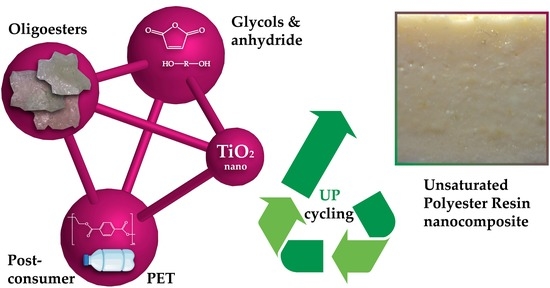Unsaturated Polyester Resin Nanocomposites Based on Post-Consumer Polyethylene Terephthalate
Abstract
:1. Introduction
- Contain sufficient concentration of hydroxyl groups to prevent the formation of cyclic oligomers and react readily;
- Do not actively release low molecular weight compounds at temperatures above PET melting point even without an autoclave.
2. Materials and Methods
2.1. Materials
2.2. Unsaturated Polyester Resins Synthesis
2.2.1. Saturated Oligoesters
2.2.2. Simultaneous Glycolysis and Interchain Exchange of Oligoesters with PET
2.2.3. Unsaturated Polyester Resins Synthesis
2.3. Preparation of Nanocomposites
2.3.1. Mixing UPR with Other Components
2.3.2. Composite Curing
2.4. Characterization of PET and Oligoesters
2.4.1. Fourier Transform Infrared Spectroscopy (FTIR)
2.4.2. Gel Permeation Chromatography (GPC)
2.4.3. Oligoesters Synthesis Conversion
2.4.4. Color
2.5. Characterization of UPR Cures
2.5.1. Density Measurement
2.5.2. Test Method for Tensile Properties
3. Results and Discussion
3.1. PET-Flakes Characterization
3.2. Oligoesters Characterization
3.2.1. OEP-1, ODEP-1, and OPP-1 Properties
3.2.2. OEPT-1, ODEEPT-1, and OPEPT-1 Properties
3.2.3. Unsaturated Polyester Resins Properties
3.3. Nanocomposites Properties
4. Conclusions
Supplementary Materials
Author Contributions
Funding
Institutional Review Board Statement
Informed Consent Statement
Data Availability Statement
Acknowledgments
Conflicts of Interest
References
- Hooshmand Zaferani, S. Introduction of polymer-based nanocomposites. In Polymer-Based Nanocomposites for Energy and Environmental Applications; Jawaid, M., Khan, M.M., Eds.; Woodhead Publishing: Sawston, UK, 2018; pp. 1–25. [Google Scholar] [CrossRef]
- Pielichowski, K.; Pielichowska, K. Polymer Nanocomposites. In Handbook of Thermal Analysis and Calorimetry, 2nd ed.; Vyazovkin, S., Koga, N., Schick, C., Eds.; Elsevier: Amsterdam, The Netherlands, 2018; Volume 6, pp. 431–485. [Google Scholar] [CrossRef]
- Vorunichev, D.S.; Vorunicheva, K.Y. Current capabilities of prototyping technologies for multilayer printed circuit boards on a 3D printer. Russ. Technol. J. 2021, 9, 28–37. [Google Scholar] [CrossRef]
- Bhawani, S.A.; Bhat, A.H.; Ahmad, F.B.; Ibrahim, M.N.M. Green polymer nanocomposites and their environmental applications. In Polymer-Based Nanocomposites for Energy and Environmental Applications; Jawaid, M., Khan, M.M., Eds.; Woodhead Publishing: Sawston, UK, 2018; pp. 617–633. [Google Scholar] [CrossRef]
- Anuar, H.; Ali, F.B.; Buys, Y.F.; Siti Nur E’zzati, M.A.; Siti Munirah Salimah, A.R.; Mahmud, M.S.; Mohd Nordin, N.; Adli, S.A. Sustainable Nanocomposites in Food Packaging. In Sustainable Polymer Composites and Nanocomposites; Inamuddin, T.S., Mishra, R.K., Asiri, A.M., Eds.; Springer: Cham, Switzerland, 2019; pp. 413–436. [Google Scholar] [CrossRef]
- Watt, E.; Picard, M.; Maldonado, B.; Abdelwahab, M.A.; Mielewski, D.F.; Drzal, L.T.; Misra, M.; Mohanty, A.K. Ocean plastics: Environmental implications and potential routes for mitigation—A perspective. RSC Adv. 2021, 11, 21447–21462. [Google Scholar] [CrossRef]
- Kirshanov, K.; Toms, R.; Melnikov, P.; Gervald, A. Investigation of Polyester Tire Cord Glycolysis Accompanied by Rubber Crumb Devulcanization. Polymers 2022, 14, 684. [Google Scholar] [CrossRef] [PubMed]
- Di Lorenzo, M.L.; Errico, M.E.; Avella, M.J. Thermal and morphological characterization of poly(ethylene terephthalate)/calcium carbonate nanocomposites. J. Mater. Sci. 2002, 37, 2351–2358. [Google Scholar] [CrossRef]
- Panda, S.; Behera, D. Unsaturated Polyester Nanocomposites. In Unsaturated Polyester Resins; Thomas, S., Hosur, M., Chirayil, C.J., Eds.; Elsevier: Amsterdam, The Netherlands, 2019; pp. 101–124. [Google Scholar] [CrossRef]
- Hassan, A.; Hau, L.Y.; Hasan, M. Effect of ammonium polyphosphate on flame retardancy, thermal stability, and mechanical properties of unsaturated polyester/phenolic/montmorillonite nanocomposites. Adv. Polym. Technol. 2015, 36, 278–283. [Google Scholar] [CrossRef] [Green Version]
- Jiang, G.; Chen, L.; Jiang, S.; Zhou, K.; Shi, X.; Mou, W. Establishment of highly effective flame-retardant unsaturated polyester resin system based on multiple strategies. Adv. Polym. Technol. 2018, 37, 2674–2686. [Google Scholar] [CrossRef]
- Chen, Z.; Jiang, M.; Chen, Z.; Chen, T.; Yu, Y.; Jiang, J. Preparation and characterization of a microencapsulated flame retardant and its flame-retardant mechanism in unsaturated polyester resins. Powder Technol. 2019, 354, 71–81. [Google Scholar] [CrossRef]
- Wicaksono, S.T.; Laksana, A.H.; Ardhyananta, H. Effect of calcium carbonate on the tensile and density properties of kenaf/polyester hybrid composite. IOP Conf. Ser. Mater. Sci. Eng. 2019, 546, 042019. [Google Scholar] [CrossRef]
- Sugiman, S.; Setyawan, P.D.; Maryudi, M.; Madnasri, S. Water absorption, tensile, flexural and impact properties of aged bamboo fibre/nano CaCO3-modified unsaturated polyester composites. J. Appl. Sci. Eng. 2021, 24, 239–251. [Google Scholar] [CrossRef]
- Sugiman, S.; Setyawan, P.D.; Thongchom, A.D.C. Effects of nano CaCO3 on the water absorption, tensile and impact properties of unsaturated polyester composites. J. Appl. Sci. Eng. 2022, 25, 465–472. [Google Scholar] [CrossRef]
- Rahman, M.T.; Asadul Hoque, M.; Rahman, G.T.; Gafur, M.A.; Khan, R.A.; Khalid Hossain, M. Study on the mechanical, electrical and optical properties of metal-oxide nanoparticles dispersed unsaturated polyester resin nanocomposites. Results Phys. 2019, 13, 102264. [Google Scholar] [CrossRef]
- Serkhacheva, N.S.; Gainanova, A.A.; Kuz’micheva, G.M.; Podbelskiy, V.V.; Sadovskaya, N.V.; Zybinskiy, A.M.; Domoroshchina, E.N.; Dorokhov, A.V.; Chernyshev, V.V.; Prokopov, N.I.; et al. Composites based on polystyrene microspheres with nano-scaled titanium dioxide. Int. J. Polym. Anal. Charact. 2015, 20, 743–753. [Google Scholar] [CrossRef]
- Serkhacheva, N.S.; Prokopov, N.I.; Gervald, A.Y.; Lobanova, N.A.; Toms, R.V.; Tsoh, A.E. Synthesis composite polystyrene microspheres with titanium dioxide by dispersion polymerization. Plast. Massy 2017, 1, 15–19. [Google Scholar] [CrossRef]
- Jiang, C.; Jin, C.; Wei, M.; Yan, S.; Chen, D. Mechanical and thermal properties improvement of unsaturated polyester resin by incorporation of TiO2 nanoparticle surface modified with titanate. Mater. Res. Express. 2018, 5, 115008. [Google Scholar] [CrossRef] [Green Version]
- Blanco, M.; Monteserín, C.; Uranga, N.; Gómez, E.; Aranzabe, E.; García, J.I. Thermal and Photocatalytic Performance of Unsaturated Polyester Resins Modified with TiO2 Nanoparticles as Panel Bodies for Vehicles. Polymers 2021, 13, 2036. [Google Scholar] [CrossRef]
- Koushali, S.K.; Hamadanian, M.; Ghasemi, A.R.; Ashrafi, M. Investigation of mechanical properties of polyester/polyethylene glycol/TiO2 nanocomposites. J. Nanostruct. 2021, 11, 38–47. [Google Scholar] [CrossRef]
- Chen, H.; Tian, X.; Liu, J. Unsaturated polyester resin nanocomposites containing ZnO modified with oleic acid activated by N,N′-carbonyldiimidazole. Polymers 2018, 10, 362. [Google Scholar] [CrossRef] [Green Version]
- Mohammed, M.; Betar, B.O.; Rahman, R.; Mohammed, A.M.; Osman, A.F.; Jaafar, M.; Adam, T.; Dahham, O.S.; Hashim, U.; Noriman, N.Z. Zinc oxide nano particles integrated kenaf/unsaturated polyester biocomposite. J. Renew. Mater. 2019, 7, 967–982. [Google Scholar] [CrossRef]
- Franco-Urquiza, E.A.; May-Crespo, J.F.; Escalante Velázquez, C.A.; Pérez Mora, R.; González García, P. Thermal degradation kinetics of ZnO/polyester nanocomposites. Polymers 2020, 12, 1753. [Google Scholar] [CrossRef]
- Mir Azizi, Z.R.; Sharifzadeh, E.; Rahimpour, F. Thermal analysis of ZnO/hollow graphene oxide/polyester complex and simple structure nanocomposites: Analytical, simulation and experimental approaches. Iran. Polym. J. 2022. [Google Scholar] [CrossRef]
- Rahman, M.T.; Hoque, M.A.; Rahman, G.T.; Azmi, M.M.; Gafur, M.A.; Khan, R.A.; Khalid Hossain, M. Fe2O3 nanoparticles dispersed unsaturated polyester resin based nanocomposites: Effect of gamma radiation on mechanical properties. Radiat. Eff. Defects Solids 2019, 174, 480–493. [Google Scholar] [CrossRef]
- Salman, K.D. synthesis and characterization unsaturated polyester resin nanocomposites reinforced by Fe2O3 + Ni nanoparticles: Influence on mechanical and magnetic properties. Int. J. Eng. Trans. 2022, 35, 21–28. [Google Scholar] [CrossRef]
- Khachaturov, A.A.; Potapov, E.E.; Reznichenko, S.V.; Kovaleva, A.N. Influence of iron ore concentrate (magnetite) on the kinetics of butadiene–styrene rubber-based blend curing in the presence of different accelerators. Fine Chem. Technol. 2020, 15, 46–53. [Google Scholar] [CrossRef]
- Poorabdollah, M.; Beheshty, M.H.; Atai, M. Investigating curing kinetics and structural relaxation phenomena of unsaturated polyester resin containing silanized silica. J. Compos. Mater. 2015, 50, 2459–2467. [Google Scholar] [CrossRef]
- Rusmirovic, J.D.; Trifkovic, K.T.; Bugarski, B.; Pavlovic, V.B.; Dzunuzovic, J.; Tomic, M.; Marinkovic, A.D. High performance unsaturated polyester based nanocomposites: Effect of vinyl modified nanosilica on mechanical properties. EXPRESS Polym. Lett. 2016, 10, 139–159. [Google Scholar] [CrossRef]
- Abdul Halim, Z.A.; Awang, N.; Yajid, M.A.M.; Ahmad, N.; Hamdan, H. A comparison between the effects of hydrophobic and hydrophilic silica aerogel fillers on tensile and thermal properties of unsaturated polyester composites. Polym. Bull. 2021, 1–19. [Google Scholar] [CrossRef]
- Gorelov, B.M.; Gorb, A.M.; Polovina, O.I.; Wacke, S.; Czapla, Z.; Kostrzewa, M.; Ingram, A. Filler’s impact on structure and physical properties in polyester resin–oxide nanocomposites. Adsorpt. Sci. Technol. 2017, 36, 549–570. [Google Scholar] [CrossRef] [Green Version]
- Laatar, F.; Jayan, M.; Padmanabhan, P.; Ben Romdhane, M.R.; Srasra, E. Unsaturated polyester-nanoclay nanocomposite coatings for effective corrosion protection of steel. J. Coat. Technol. Res. 2017, 15, 293–301. [Google Scholar] [CrossRef]
- Poorabdollah, M.; Kamran, A. Optimising cure cycle of unsaturated polyester nanocomposites using directed grid search method. Polym. Polym. Compos. 2019, 27, 253–261. [Google Scholar] [CrossRef]
- Abobo, I.M.D.; Rodriguez, L.D.; Salvador, S.D.; Siy, H.C.; Penaloza, D.P., Jr. Effect of organoclay reinforcement on the mechanical and thermal properties of unsaturated polyester resin composites. J. Silicon Based Polym. Mater. 2021, 73, 63–67. [Google Scholar] [CrossRef]
- Rusmirović, J.D.; Rančić, M.P.; Pavlović, V.B.; Rakić, V.M.; Stevanović, S.; Djonlagić, J.; Marinković, A.D. Cross-Linkable Modified Nanocellulose/Polyester Resin-Based Composites: Effect of Unsaturated Fatty Acid Nanocellulose Modification on Material Performances. Macromol. Mater. Eng. 2018, 303, 1700648. [Google Scholar] [CrossRef]
- Tasić, A.; Rusmirović, J.D.; Nikolić, J.; Božić, A.; Pavlović, V.; Marinković, A.D.; Uskoković, P.S. Effect of the vinyl modification of multi-walled carbon nanotubes on the performances of waste poly(ethylene terephthalate)-based nanocomposites. J. Compos. Mater. 2016, 51, 491–505. [Google Scholar] [CrossRef]
- Salehi, M.; Krishnamurthy, A.; Forster, A.M.; Hsiao, K.-T.; Whelton, A.J. Polyester composite water uptake and organic contaminant release affected by carbon nanofiber reinforcements. J. Appl. Polym. Sci. 2016, 133, 43724. [Google Scholar] [CrossRef]
- Moshiul Alam, A.K.M.; Beg, M.D.H.; Yunus, R.M.; Bijarimi, M.; Mina, M.F.; Maria, K.H.; Mieno, T. Modification of structure and properties of well-dispersed dendrimer coated multi-walled carbon nanotube reinforced polyester nanocomposites. Polym. Test. 2018, 68, 116–125. [Google Scholar] [CrossRef]
- Hashemi, M.; Shojaei, A. Morphology development and mechanical properties of unsaturated polyester resin containing nanodiamonds. Polym. Int. 2017, 66, 950–959. [Google Scholar] [CrossRef]
- Saleh, B.; El Mogy, S.A. Use of waste rubber and bionanofiller in preparation of rubber nanocomposites for friendly environmental flooring applications. Egypt J. Chem. 2020, 63, 2457–2471. [Google Scholar] [CrossRef]
- Markov, A.V.; Tarasova, K.S.; Markov, V.A. Effect of relaxation processes during deformation on electrical resistivity of carbon black polypropylene composites. Fine Chem. Technol. 2021, 16, 345–351. [Google Scholar] [CrossRef]
- Wilson García, N.A.; Almaral Sánchez, J.L.; Vargas Ortiz, R.Á.; Hurtado Macías, A.; Flores Ramírez, N.; Aguilar Palazuelos, E.; Flores Valenzuela, J.; Castro Beltran, A.; Alvarado Beltrán, C.G. Physical and mechanical properties of unsaturated polyester resin matrix from recycled PET (based PG) with corn straw fiber. J. Appl. Polym. Sci. 2021, 138, 51305. [Google Scholar] [CrossRef]
- Balashov, M.S.; Kirshanov, K.A.; Toms, R.V.; Suvorov, N.V.; Gervald, A.Y. Determination of qualitative and quantitative unsaturated polyester resins composition using NMR spectroscopy. Plast. Massy 2022, 1, 28–33. [Google Scholar] [CrossRef]
- Damayanti; Wu, H.-S. Strategic Possibility Routes of Recycled PET. Polymers 2021, 13, 1475. [Google Scholar] [CrossRef]
- Shojaei, B.; Abtahi, M.; Najafi, M. Chemical recycling of PET: A stepping-stone toward sustainability. Polym. Adv. Technol. 2020, 31, 2912–2938. [Google Scholar] [CrossRef]
- Barnard, E.; Jonathan, J.; Arias, R.; Thielemans, W. Chemolytic depolymerisation of PET: A review. Green Chem. 2021, 23, 3765–3789. [Google Scholar] [CrossRef]
- Kirshanov, K.A.; Gerval’d, A.Y.; Toms, R.V. Obtaining oligoesters by directed glycolytic destruction of polyethylene terephthalate waste. Plast. Massy 2020, 1, 51–53. [Google Scholar] [CrossRef]
- Kirshanov, K.A.; Toms, R.V. Study of polyethylene terephthalate glycolysis with a mixture of bis(2-hydroxyethyl) terephthalate and its oligomers. Plast. Massy 2021, 1, 50–52. [Google Scholar] [CrossRef]
- Duque-Ingunza, I.; López-Fonseca, R.; de Rivas, B.; Gutiérrez-Ortiz, J.I. Synthesis of unsaturated polyester resin from glycolysed postconsumer PET wastes. J. Mater. Cycles Waste 2013, 15, 256–263. [Google Scholar] [CrossRef]
- Colomines, G.; Robin, J.-J.; Tersac, G. Study of the glycolysis of PET by oligoesters. Polymer 2005, 46, 3230–3247. [Google Scholar] [CrossRef]
- Colomines, G.; Rivas, F.; Lacoste, M.-L.; Robin, J.-J. Study of Polyurethane Formulations Containing Diols Obtained via Glycolysis of Poly(ethylene terephthalate) (PET) by Oligoesters Diols through a Reactive Extrusion Process. Macromol. Mater. Eng. 2005, 290, 710–720. [Google Scholar] [CrossRef]
- Joshi, A.S.; Alipourasiabi, N.; Vinnakota, K.; Coleman, M.R.; Lawrence, J.G. Improved polymerization and depolymerization kinetics of poly(ethylene terephthalate) by copolymerization with 2,5-furandicarboxylic acid. RSC Adv. 2021, 11, 23506–23518. [Google Scholar] [CrossRef]
- Allcock, H.R.; Lampe, F.W.; Mark, J.E. Contemporary Polymer Chemistry, 3rd ed.; Pearson Education: Upper Saddle River, NJ, USA, 2003; p. 324. [Google Scholar] [CrossRef]
- Ziyu, C.; Hay, J.N.; Jenkins, M.J. FTIR spectroscopic analysis of poly(ethylene terephthalate) on crystallization. Eur. Polym. J. 2012, 48, 1586–1610. [Google Scholar] [CrossRef]
- Rieckmann, T.; Volker, S. Poly(ethylene terephthalate) polymerization—Mechanism, catalysis, kinetics, mass transfer and reactor design. In Modern Polyesters: Chemistry and Technology of Polyesters and Copolyesters; Scheirs, J., Long, T.E., Eds.; John Wiley & Sons: London, UK, 2003; pp. 31–116. [Google Scholar] [CrossRef]
- El Mejjatti, A.; Harit, T.; Riahi, A.; Khiari, R.; Bouabdallah, I.; Malek, F. Chemical recycling of poly(ethylene terephthalate). Application to the synthesis of multiblock copolyesters. EXPRESS Polym. Lett. 2014, 8, 544553. [Google Scholar] [CrossRef] [Green Version]




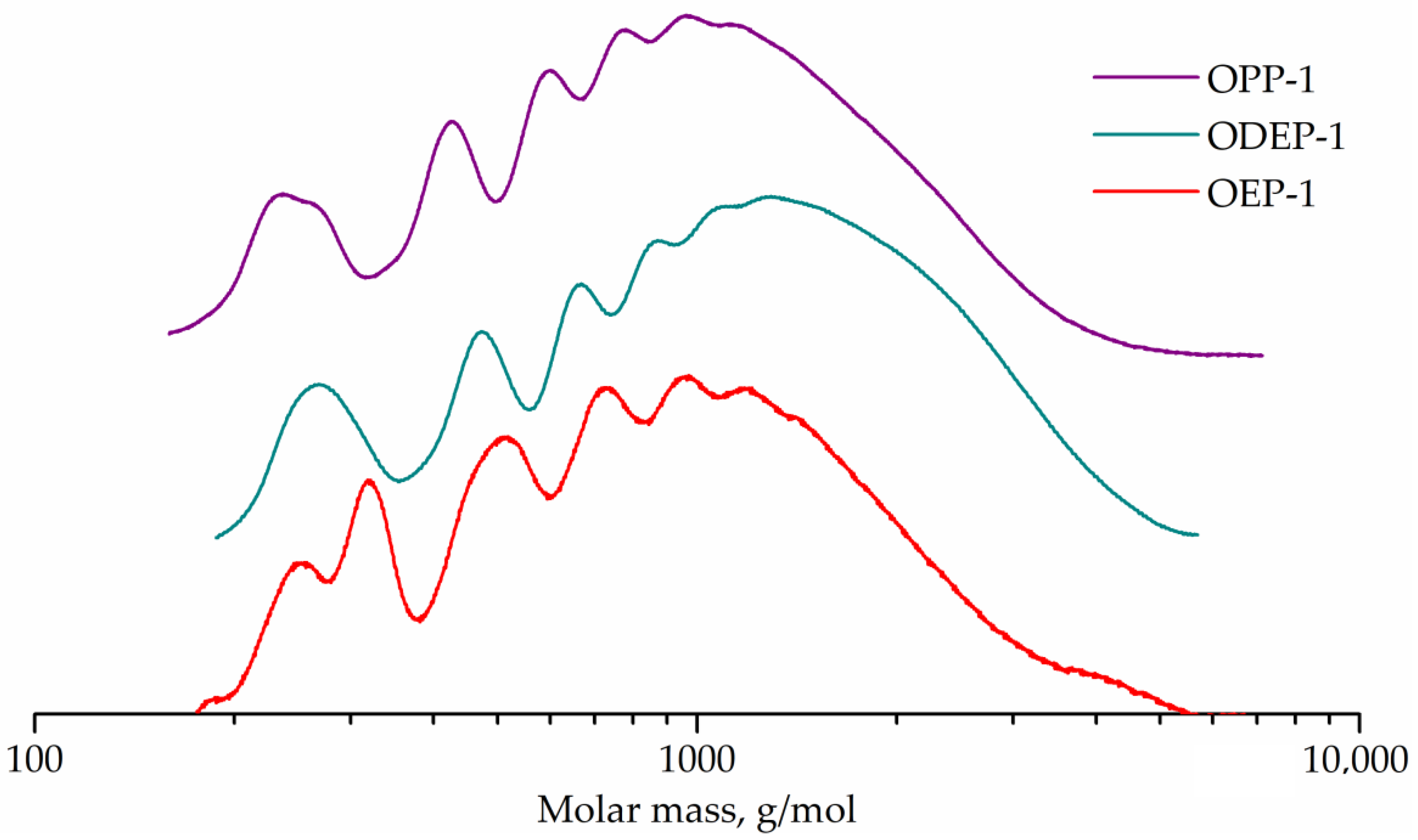

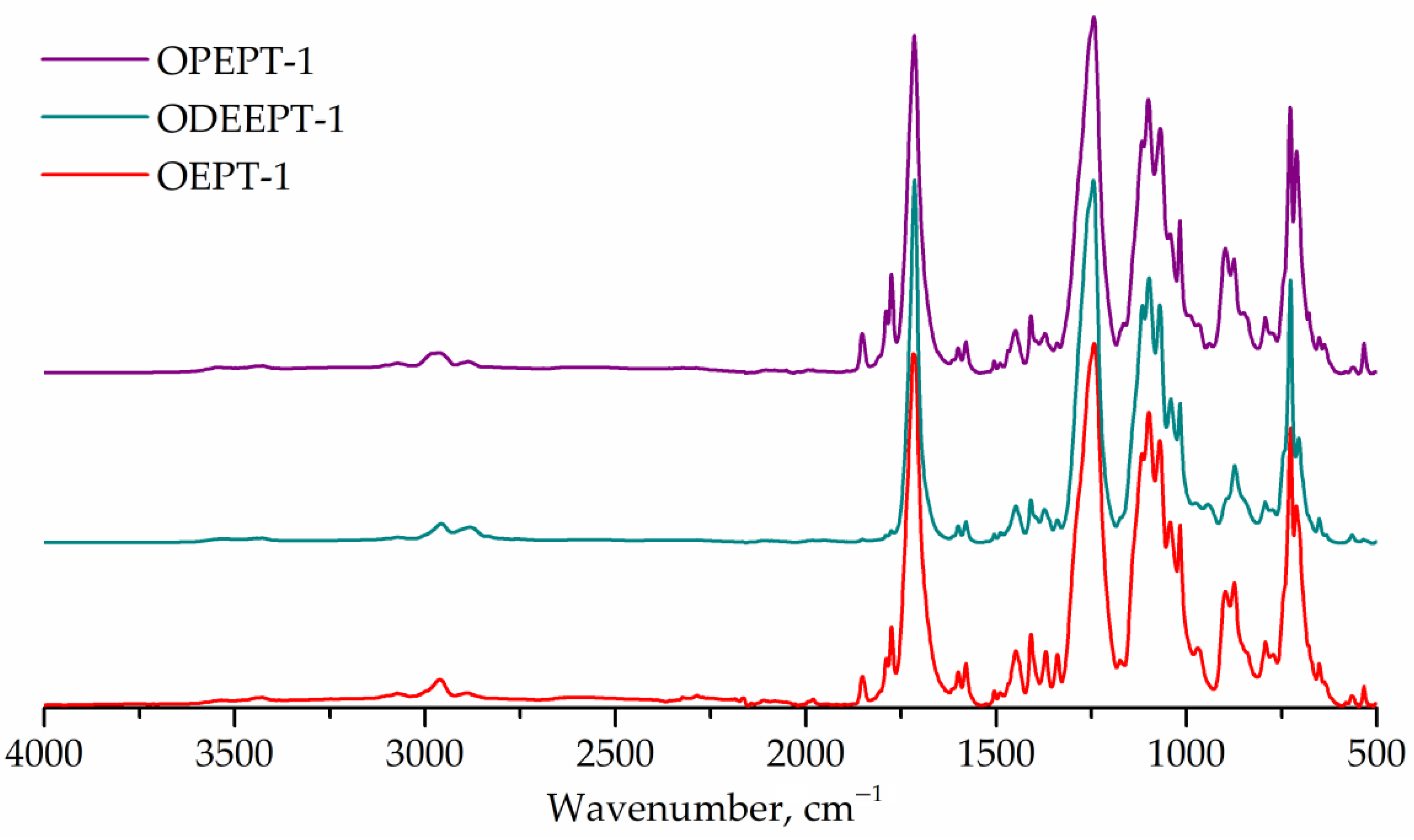
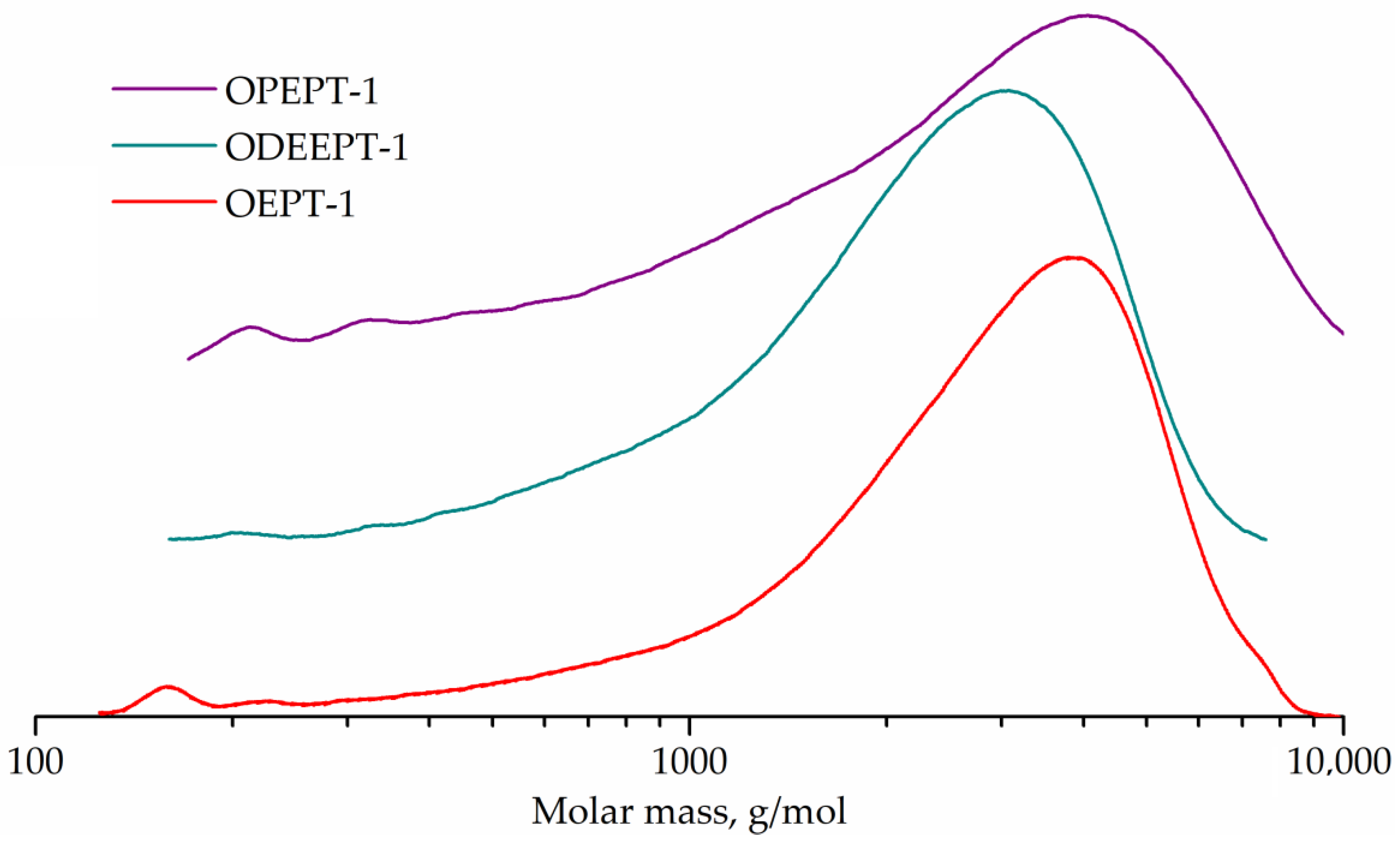
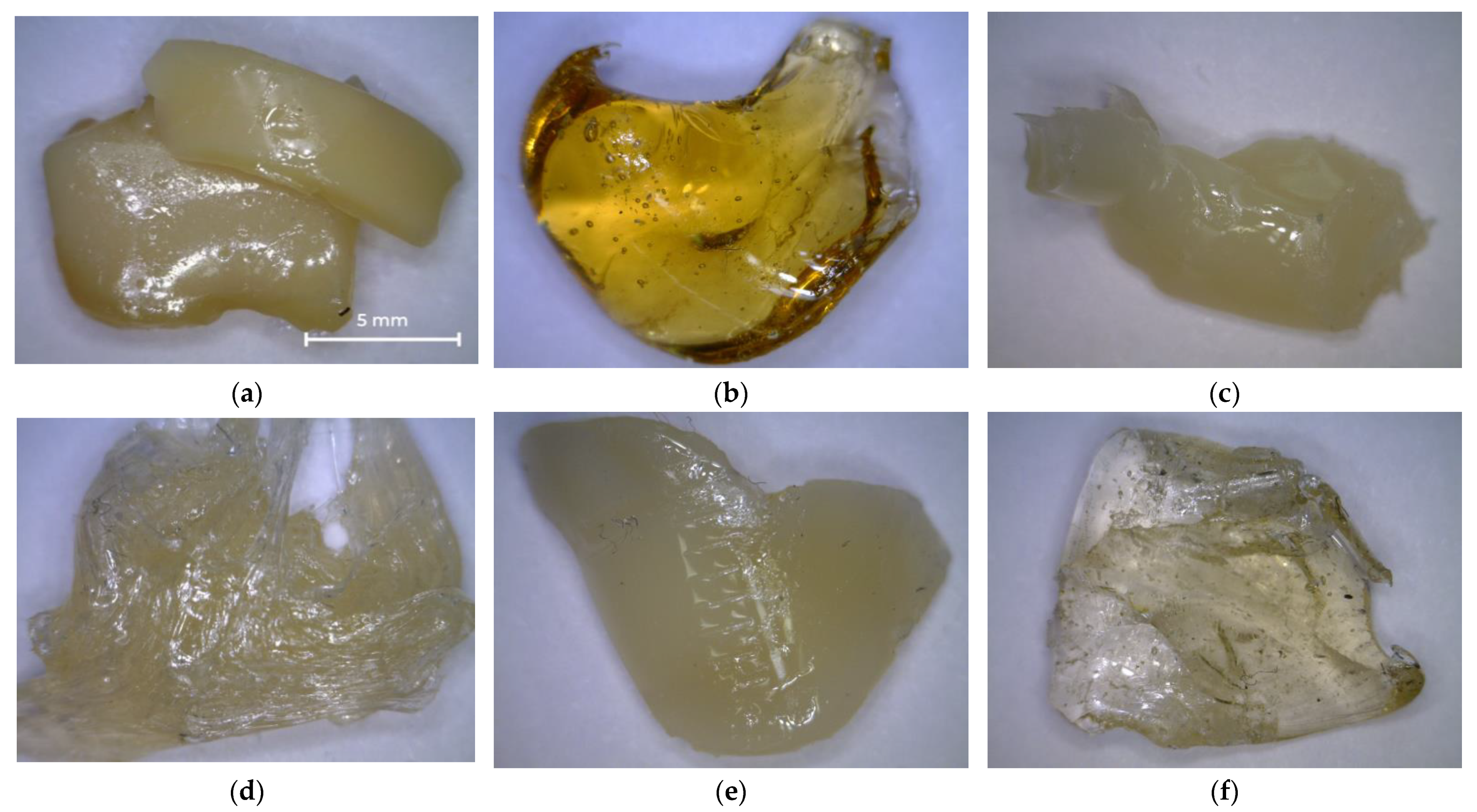

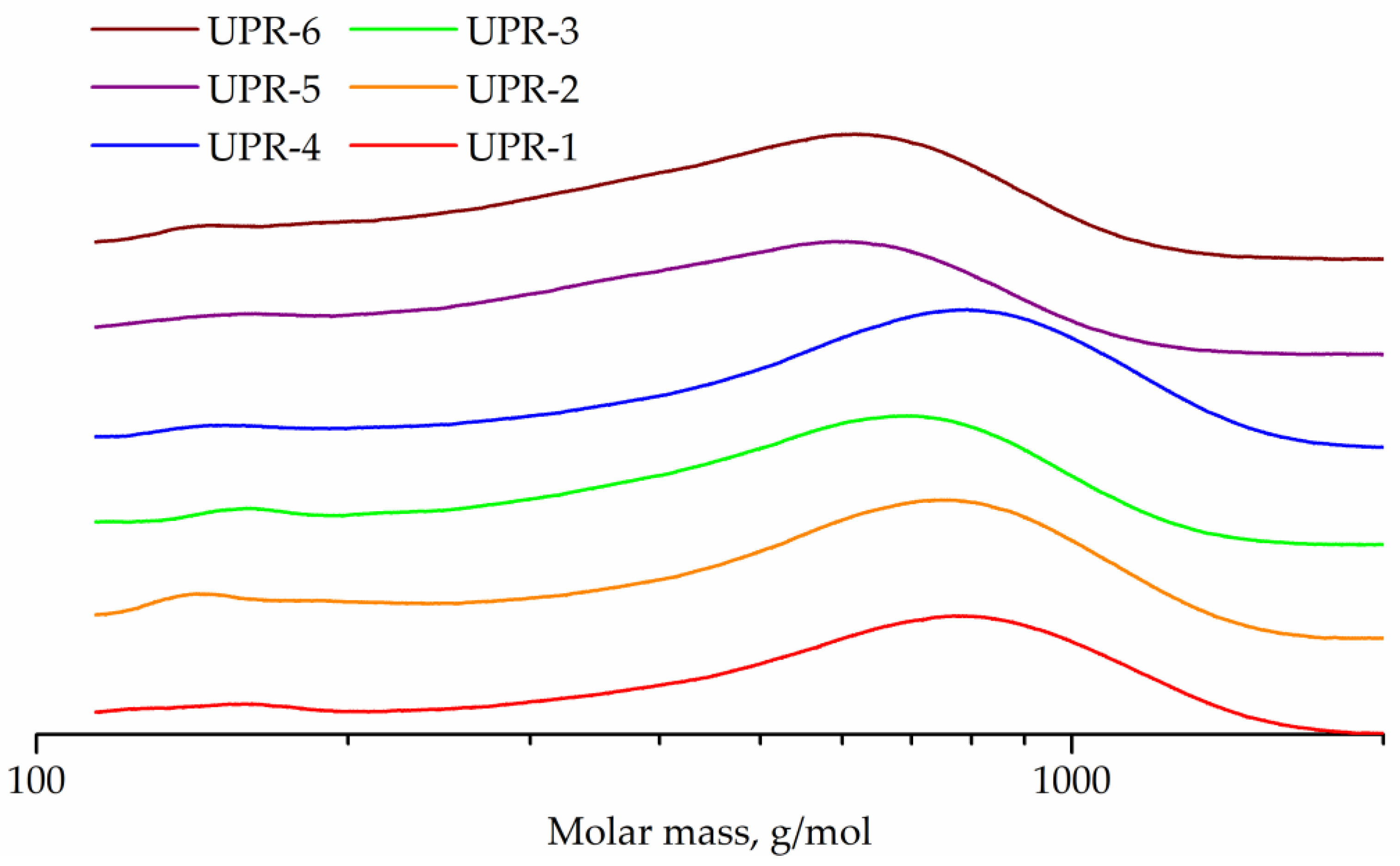
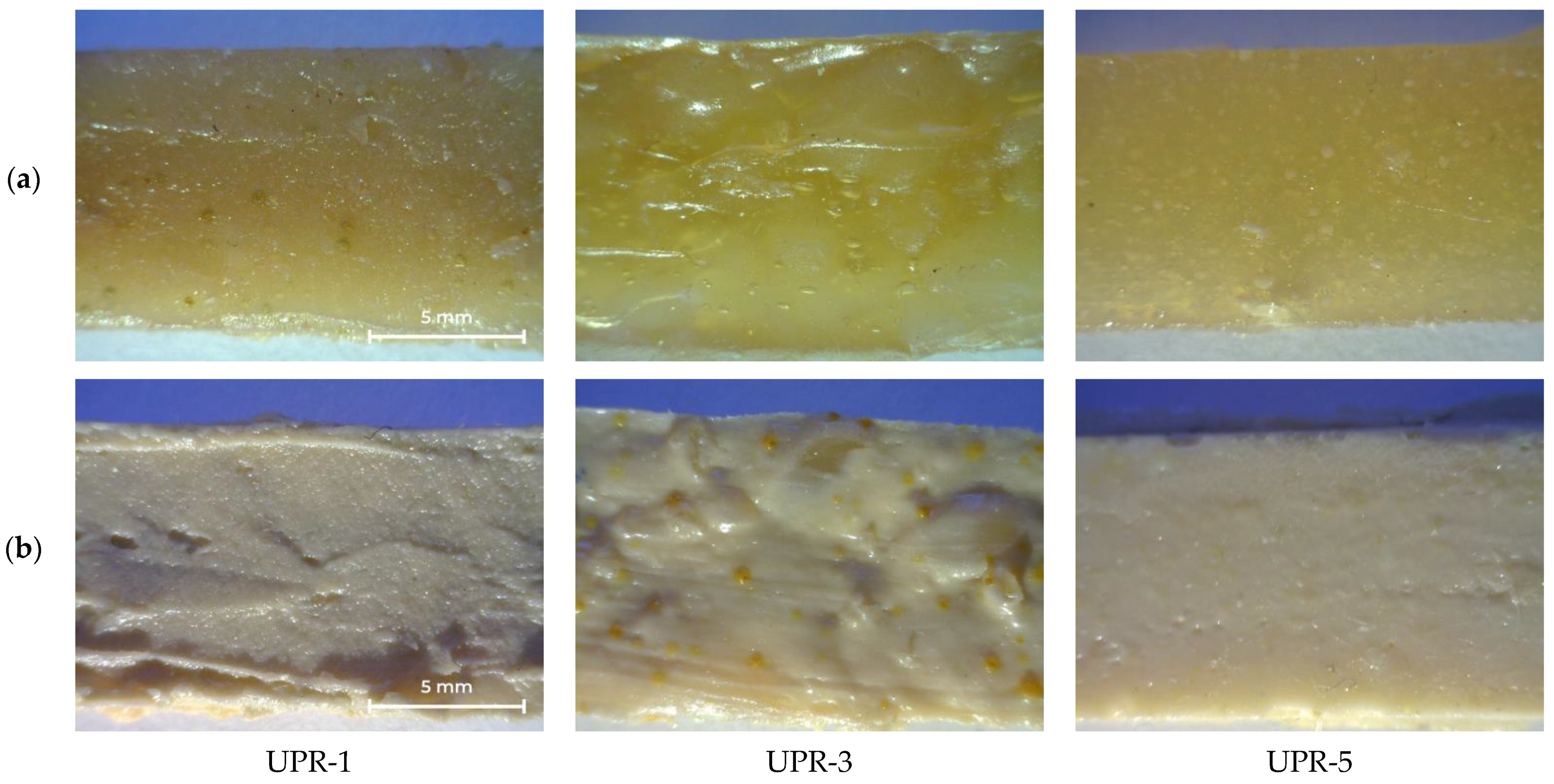
| Reagents | OEP-1 | ODEP-1 | OPP-1 |
|---|---|---|---|
| PA | 4 | 4 | 4 |
| EG | 5 | 0 | 0 |
| DEG | 0 | 5 | 0 |
| PG | 0 | 0 | 5 |
| Reagents | UPR-1 | UPR-2 | UPR-3 | UPR-4 | UPR-5 | UPR-6 |
|---|---|---|---|---|---|---|
| MA | 1 | 1 | 1 | 1 | 1 | 1 |
| OEPT-1 | 2 | 2 | 0 | 0 | 0 | 0 |
| ODEEPT-1 | 0 | 0 | 2 | 2 | 0 | 0 |
| OPEPT-1 | 0 | 0 | 0 | 0 | 2 | 2 |
| DEG | 1 | 0 | 1 | 0 | 1 | 0 |
| PG | 0 | 1 | 0 | 1 | 0 | 1 |
| Sample | Mn, g/mol | Mw, g/mol | PDI | Conversion, % | Color |
|---|---|---|---|---|---|
| OEP-1 | 684 | 1100 | 1.61 | 97.65 | 3 |
| ODEP-1 | 835 | 1368 | 1.64 | 97.04 | 1 |
| OPP-1 | 667 | 1096 | 1.64 | 95.96 | 1 |
| Sample | Mn, g/mol | Mw, g/mol | PDI | Conversion, % | Color |
|---|---|---|---|---|---|
| OEPT-1 | 1519 | 3053 | 2.01 | 96.81 | 9 |
| ODEEPT-1 | 1786 | 2594 | 1.45 | 97.01 | 5 |
| OPEPT-1 | 1600 | 3272 | 2.04 | 96.86 | 4 |
| Sample | Mn, g/mol | Mw, g/mol | PDI | Color |
|---|---|---|---|---|
| UPR-1 | 446 | 657 | 1.47 | Cloudy |
| UPR-2 | 416 | 640 | 1.54 | 10 |
| UPR-3 | 410 | 574 | 1.40 | Cloudy |
| UPR-4 | 492 | 692 | 1.41 | 7 |
| UPR-5 | 354 | 490 | 1.38 | Cloudy |
| UPR-6 | 381 | 517 | 1.36 | 4 |
| Resin Sample | Nanofiller Content, wt% | Density, g/mm3 | Tensile Strength, MPa | Elongation at Break, % | Young’s Modulus, MPa |
|---|---|---|---|---|---|
| UPR-1 | 0 | 1.22 | 3.61 | 27.14 | 0.62 |
| 5 | 1.26 | 3.69 | 32.89 | 0.83 | |
| UPR-2 | 0 | Insoluble in styrene | |||
| 5 | |||||
| UPR-3 | 0 | 1.24 | 34.32 | 21.68 | 7.33 |
| 5 | 1.28 | 9.85 | 33.66 | 1.99 | |
| UPR-4 | 0 | Forms a physical gel | |||
| 5 | |||||
| UPR-5 | 0 | 1.26 | 51.86 | 127.06 | 9.65 |
| 5 | 1.29 | 112.62 | 157.94 | 29.95 | |
| UPR-6 | 0 | Forms a physical gel | |||
| 5 | |||||
Publisher’s Note: MDPI stays neutral with regard to jurisdictional claims in published maps and institutional affiliations. |
© 2022 by the authors. Licensee MDPI, Basel, Switzerland. This article is an open access article distributed under the terms and conditions of the Creative Commons Attribution (CC BY) license (https://creativecommons.org/licenses/by/4.0/).
Share and Cite
Kirshanov, K.; Toms, R.; Melnikov, P.; Gervald, A. Unsaturated Polyester Resin Nanocomposites Based on Post-Consumer Polyethylene Terephthalate. Polymers 2022, 14, 1602. https://doi.org/10.3390/polym14081602
Kirshanov K, Toms R, Melnikov P, Gervald A. Unsaturated Polyester Resin Nanocomposites Based on Post-Consumer Polyethylene Terephthalate. Polymers. 2022; 14(8):1602. https://doi.org/10.3390/polym14081602
Chicago/Turabian StyleKirshanov, Kirill, Roman Toms, Pavel Melnikov, and Alexander Gervald. 2022. "Unsaturated Polyester Resin Nanocomposites Based on Post-Consumer Polyethylene Terephthalate" Polymers 14, no. 8: 1602. https://doi.org/10.3390/polym14081602
APA StyleKirshanov, K., Toms, R., Melnikov, P., & Gervald, A. (2022). Unsaturated Polyester Resin Nanocomposites Based on Post-Consumer Polyethylene Terephthalate. Polymers, 14(8), 1602. https://doi.org/10.3390/polym14081602








